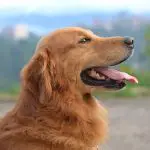Bloat & torsion in large breed dogs
Gastric torsion is seen most often in large breeds including the Great Dane and Bloodhound as well as some of the intermediate size breeds. Torsion of the stomach is the abnormal positioning of the stomach caused by the stomach rotation about its axis. This is better explained as a mechanical twist of the stomach. In essence, the stomach becomes filled with gas, food, liquid, or a combination thereof which causes the stomach to become abnormally enlarged or distended. At this point when a dog engages in a sudden jump or plays and rolls around, the stomach actually swings in a pendulum-like motion which results with it swinging completely around the fixation point of the stomach where the esophagus passes through the diaphragm, thus giving rise to a twist.
Gastric dilatation and volvulus, also referred to as GDV, is more commonly called bloat. This is what usually leads to torsion, although torsion can occur without bloat. Chronic gastric volvulus, which is ongoing mild torsion, may not cause typical signs of GDV, but should be suspected in dogs with intermittent vomiting, weight loss, mild bloating, rumbling sounds in the bowel known as borborygmi, or belching. Depending on how quickly the problem is dealt with, GDV may result in a stomach that is rotated by anywhere from 90 degrees to 360.
Severe torsion usually means the displacement of both the stomach and the spleen as they actually exchange positions. The speed, at which the stomach empties itself, as well as the stomach digestive contraction pace, is thought to play a role in the development of GDV. Certain food types such as peas, onions, beans, beet pulp, etc. are also implicated.
Gastric dilatation and volvulus most commonly occurs in large breeds, but has also been reported in Bassets, Dachshunds and cats. Reported fatality rates range from 15 percent to 60. There is also a high recurrence rate when Gastropexy surgery is not performed to permanently attach the stomach to an anatomically acceptable part of the body, such as a rib. Bloat surgery is a very painful, major operation and is potentially life threatening especially in cases involving old dogs. Dr. John Lammerding, a board certified veterinary surgeon, with extensive clinical experience with GDV cases, believes that GDV in old dogs are typically caused by excessive hyperventilation via sucking too much air due to the fact that some old dogs, like old people, develop breathing difficulties due to the aging process. Theoretically, this state of hyperventilation can then be prevented by keeping the old dog calm and preventing him or her from hyperventilating. With young dogs, Dr. Lammerding suggests more of a genetic predisposition.
Regardless of the cause of GDV, the end result is a distended and twisted stomach. GDV results in physiological changes that create a medical and surgical emergency. Treatment must be instituted immediately if the animal is to survive. If the dog cannot be treated immediately by a veterinarian, the owner may be forced to render first aid to his dog.
Prevention of this condition is the best choice, and it is highly recommended that you should discuss the treatment of bloat and torsion with your veterinarian the next time you schedule an appointment. Not all veterinarians are familiar with the proper emergency treatment of GDV and fewer yet are familiar with proper surgical technique and post surgery care and monitoring. It is imperative that you make sure that your veterinarian is familiarized with the proper procedures before his or her skills are needed. If your veterinarian is not receptive to or is offended by your queries, then it may perhaps be time for you to find a more responsive veterinarian.


